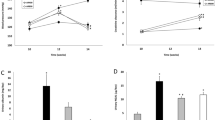Summary
The role of hydrogen sulfide (H2S) in portal hypertension (PH)-induced esophagus-gastric junction vascular lesions in rabbits was observed. The rabbit PH models were established. The animals were randomly divided into the following groups: normal, PH, PH+sodium hydrosulfide (PH+S), PH+propargylglycine (PH+PPG). The plasma H2S levels, apoptosis of esophageal-gastric junction vascular smooth muscle cells, and the expression of nuclear transcription factor-κB (NF-κB), p-AKT, IκBa and Bcl-2 were detected. The cystathionine γ lyase (cystathionine-gamma-splitting enzyme, CSE) in the junction vascular tissue was measured. The results showed that the plasma H2S levels and the CSE expression levels had statistically significant difference among different groups (P<0.05). As compared with PH group, plasma H2S levels were declined obviously (11.9±4.2 vs. 20.6±4.5, P<0.05), and CSE expression levels in the junction vascular tissue were notably reduced (1.7±0.6 vs. 2.8±0.8, P<0.05), apoptosis rate of vascular smooth muscle cells per unit area was significantly decreased (0.10±0.15 vs. 0.24±0.07, P<0.05), and the expression levels of p-AKT and NF-κB were significantly decreased (2.31±0.33 vs. 3.04±0.38, P<0.05; 0.33±0.17 vs. 0.51±0.23, P<0.05), however, IκBa and Bcl-2 expression increased obviously (5.57±0.17 vs. 3.67±0.13, P<0.05; 0.79±0.29 vs. 0.44±0.36, P<0.05) in PH+PPG group. As compared with PH group, H2S levels were notably increased (32.7±7.3 vs. 20.6±4.5, P<0.05), the CSE levels in the junction vascular tissue were significantly increased (6.3±0.7 vs. 2.8±0.8, P<0.05), apoptosis rate of vascular smooth muscle cells per unit area was significantly increased (0.35±0.14 vs. 0.24±0.07, P<0.05), and the expression levels of p-AKT and NF-κB were significantly increased (4.29±0.49 vs. 3.04±0.38, P<0.05; 0.77±0.27 vs. 0.51±0.23, P<0.05), yet IκBa and Bcl-2 expression decreased significantly (3.23±0.24 vs. 3.67±0.13, P<0.05; 0.31±0.23 vs. 0.48±0.34, P<0.05) in PH+S group. It is concluded that esophagus-gastric junction vascular lesions happen under PH, and apoptosis of smooth muscle cells is declined. H2S can activate NF-κB by the p-AKT pathway, leading to the down-regulation of Bcl-2, eventually stimulating apoptosis of vascular smooth muscle cells, easing PH. H2S/CSE system may play an important role in remission of PH via the AKT-NF-κB pathway.
Similar content being viewed by others
References
Liu H, Zheng Y. Endogenous hydrogen sulfide and liver fibrosis. Gastroenterol Liver Dis (Chinese), 2011,20(12):1077–1080
Qian JR, Huang W. Effect of hydrogen sulfide on the ultrastructure of gastric antrum Cajal interstitial cells of rats with cirrhotic portal hypertension. Zhongnan Yaoxue (Chinese), 2015,6:609–612
Wang C, Han J, Xiao L, et al. Role of hydrogen sulfide in portal hypertension and esophagogastric junction vascular disease. World J Gastroenterol, 2014,20(4):1079–1087
Tan G, Pan S, Li J, et al. Hydrogen sulfide attenuates carbon tetrachloride-induced hepatotoxicity, liver cirrhosis and portal hypertension in rats. PLoS One, 2011,6(10):e25943
Ci L, Yang X, Gu X, et al. Cystathionine lyase deficiency exacerbates CCl4-induced acute hepatitis and fibrosis in the mouse liver. Antioxid Redox Signal, 2017 Apr 4. doi: 10.1089/ars.2016.6773. [Epub ahead of print]
Fan HN, Wang HJ, Ren L, et al. Decreased expression of p38 MAPK mediates protective effects of hydrogen sulfide on hepatic fibrosis. Eur Rev Med Pharmacol Sci, 2013,17(5):644–652
Nalli AD, Rajagopal S, Mahavadi S, et al. Inhibition of RhoA-dependent pathway and contraction by endogenous hydrogen sulfide in rabbit gastric smooth muscle cells. Am J Physiol Cell Physiol, 2015,308(6):C485–495
Wang C, Han J, Li D, et al. Mechanism of hydrogen sulfide promoting apoptosis of vascular smooth muscle cells at esophagus-stomach junction in elderly rabbit portal hypertension. Chin J Exp Surg (Chinese), 2014,31(8):1735–1738
Chen WG, Zheng Y, Song LX, et al. Endogenous hydrogen sulfide attenuates portal hypertension in rats with experimental hepatic cirrhosis. World Chin J Digestol (Chinese), 2011,19(5):467–471
Kodela R, Nath N, Chattopadhyay M, et al. Hydrogen sulfide-releasing naproxen suppresses colon cancer cell growth and inhibits NF-?B signaling. Drug Des Devel Ther, 2015,2015(9):4873–4882
Pavoni V, Nicoletti P, Benemei S, et al. Effects of hydrogen sulfide (H2S) on mesenteric perfusion in experimental induced intestinal ischemia in a porcine model. Heart Lung Vessel, 2015,7(3):231–237
Song K, Li Q, Yin XY, et al. Hydrogen sulfide: a therapeutic candidate for fibrotic disease? Oxid Med Cell Longev, 2015,2015:458720
Zhao Q, Chen WG, Zheng Y, et al. Hydrogen sulfide decreases collagen I and collagen III expression in the liver of rats with experimental hepatic fibrosis. Word Chin J Digestol (Chinese), 2013,4(21):300–306
Yan-nan B, Zhao-yan Y, Li-xi L, et al. MicroRNA-21 accelerates hepatocyte proliferation in vitro via PI3K/Akt signaling by targeting PTEN. Biochem Biophys Res Commun, 2014,443(3):802–807
Xiao T, Luo J, Wu Z, et al. Effects of hydrogen sulfide on myocardial fibrosis and PI3K/AKT1-regulated autophagy in diabetic rats. Cell Physiol Biochem, 2015,36(3):917–929
Rao CY, Fu LY, Hu CL, et al. H2S mitigates severe acute pancreatitis through the PI3K/AKT-NF-?B pathway in vivo. World J Gastroenterol, 2015,21(15):4555–4563
Yue YL, Song LX, Zheng NN, et al. Exogenous hydrogen sulfide promotes proliferation and inhibits apoptosis of hepatocytes via PI3K/Akt pathway. World Chin J Digestol, 2014,22(36):5602–5608
Guo C, Liang F, Shah Masood W, et al. Hydrogen sulfide protected gastric epithelial cell from ischemia/reperfusion injury by Keap1 s-sulfhydration, MAPK dependent anti-apoptosis and NF-?B dependent anti-inflammation pathway. Eur J Pharmacol, 2014,725:70–78
Liu H, Deng Y, Gao J, et al. Sodium hydrosulfide attenuates beta-amyloid-induced cognitive deficits and neuroinflammation via modulation of MAPK/NF-?B pathway in rats. Curr Alzheimer Res, 2015,12(7):673–683
Author information
Authors and Affiliations
Corresponding author
Additional information
This project was supported by Doctoral Research Funding of the Education Department of China (No. 20120142120048).
Rights and permissions
About this article
Cite this article
Wang, C., Han, J., Li, Dj. et al. Protective effects of hydrogen sulfide on portal hypertensive vasculopathy in rabbits by activating AKT-NF-κB pathway. J. Huazhong Univ. Sci. Technol. [Med. Sci.] 37, 348–351 (2017). https://doi.org/10.1007/s11596-017-1738-4
Received:
Revised:
Published:
Issue Date:
DOI: https://doi.org/10.1007/s11596-017-1738-4




